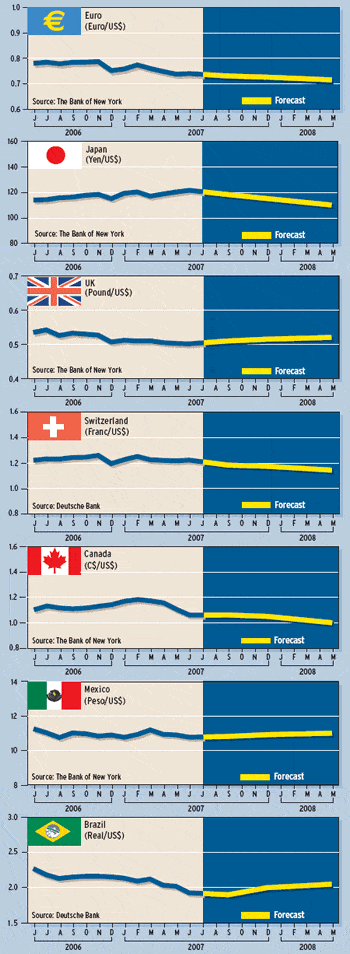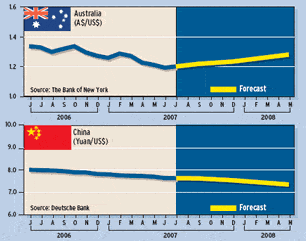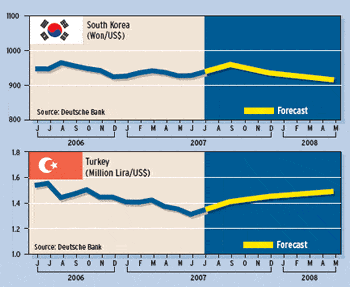Foreign exchange
Prospects for a Federal Reserve interest rate cut later this year have given way to worries that the Fed’s tightening cycle may not be over. With the outlook for monetary policy playing a large part in currency movements, the dollar has rebounded in recent weeks from its decline to record lows against the euro, although analysts seem to lack conviction on the greenback’s near-term direction.
Given that the dollar bottomed out in May and appears to have anticipated the shift in Fed views, much of the good news on rebounding US economic growth already has been priced into the market, analysts say. “Yet it is one thing to take out a Fed cut and another to price in a Fed hike,” says Marc Chandler, global head of currency strategy at Brown Brothers Harriman in New York. Two important and related developments stand out in recent weeks: a rise in global bond yields and strong growth figures, particularly in the United States, he points out.
There do seem to be a few more primary dealers who have swung over to Chandler’s long-held view that the Fed may need to raise interest rates later this year if the US economy continues to gain momentum and inflation remains a concern. Chandler says that market participants need to gain confidence that the recent rebound in the economy is not simply a payback for the near stagnation in the first quarter but the beginning of a sustained upward move before they bid the dollar higher. “We suspect this will be the case, but it is not obvious yet,” he says.
The risks of another Fed rate hike in this cycle should not be so easily dismissed, Chandler cautions. Forecasts for US second-quarter gross domestic product already were being raised when the report of a narrowing in the trade deficit in April encouraged further upward revisions to US second-quarter growth estimates.
Meanwhile, the European Central Bank raised its benchmark interest rate on June 6 by 25 basis points to 4%, in line with market expectations. “After today’s increase, given the positive economic environment in the euro area, our monetary policy is still on the accommodative side, with overall financing conditions favorable, money and credit growth vigorous, and liquidity in the euro area ample,” the ECB said in the accompanying press conference statement. “Risks to the medium-term outlook for price stability remain on the upside, relating in particular to the domestic side,” it added.
Notably, the code word “vigilance” in fighting inflation was removed from the ECB statement, which effectively removed any lingering expectations for a rate hike in July, according to Michael Woolfolk, senior currency strategist at The Bank of New York. The inclusion of the phrase “still on the accommodative side,” however, indicates another rate hike is in the works two or three months hence, most likely at the September meeting, he predicts.
ECB president Jean-Claude Trichet said in his June press conference, “If there will be a need for strong vigilance in the future, I will tell you.” The ECB decision and Trichet’s press conference prompted some euro weakness against the dollar, the British pound and the Japanese yen.
According to Woolfolk, the negative euro reaction was due in part to disappointment that the word “vigilance” was removed from the ECB statement and in part to disappointment that the 2008 inflation rate forecast was left at 2%. “Some market players had held out hopes that continuing upside surprises to European growth and inflation data justified a more hawkish stance,” he says. “While the ECB did raise its 2007 growth forecast, it refused to change its monetary policy stance.”
If and when the ECB raises rates again, it could be taken as a sign that European rates have peaked. Euro area output growth should remain above trend in 2007, says Gabriel Stein, chief international economist at London-based Lombard Street Research. “To that extent, the ECB is justified in raising interest rates further,” he says. “However, with growth slowing to or around trend in 2008 and energy prices coming down on weaker demand, there should be little need for the ECB to take its repo rate above 4.25% and certainly not beyond 4.5%.”
Credit growth in Europe has clearly turned down already, Stein says, driven mainly by a sharp slowdown in mortgage borrowing but also by somewhat weaker corporate loan growth. Auto sales are also showing signs of being past their best, he says. These could be early indications that the boom in Europe is coming to an end, he adds.
Meanwhile, Japan raised its first-quarter economic growth to an annual rate of 3.3% from 2.4% originally reported because business investment was stronger than initially estimated. The report confirmed that Japan’s economy, the second largest in the world, remained in a healthy recovery phase in the first three months of this year.
The global rise in bond yields reflects a pronounced shift in market expectations regarding the outlook for global growth, according to Woolfolk of The Bank of New York. Market participants are likely to rotate out of bonds, where prices are falling, and into equities over the next 12 months, he says.
“Until the Bank of Japan puts is money where its mouth is and begins normalizing interest rates, the yen carry trade will remain alive and well and continue feeding the global equity-market rally,” Woolfolk says. Carry trades involve borrowing in a low-interest-rate currency and investing the proceeds in a higher-yielding currency.
There are two general views on the financial markets, says Chandler of Brown Brothers Harriman.
According to the first view, Chandler explains, the rise in global rates and the shift in expectations of Fed policy are changing the investment climate, and market participants will price risk more appropriately. “This means, so the argument goes, that that the carry-trade strategies and the love affair with emerging markets will wind down,” he says.
The second, more benign view is that the rise in rates is a recognition that growth in the US has accelerated, Chandler says. The confirmation of a soft landing for the US economy, according to this view, is a positive development for the world economy and creates an environment conducive to continued expansion in emerging markets.



Gordon Platt



